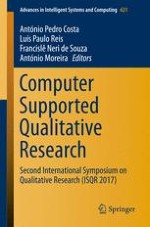2018 | OriginalPaper | Chapter
How Does Qualitative Explain Specific and Different Tendencies in Quantitative Findings?
Author : Thi Tuyet Tran
Published in: Computer Supported Qualitative Research
Publisher: Springer International Publishing
Activate our intelligent search to find suitable subject content or patents.
Select sections of text to find matching patents with Artificial Intelligence. powered by
Select sections of text to find additional relevant content using AI-assisted search. powered by
